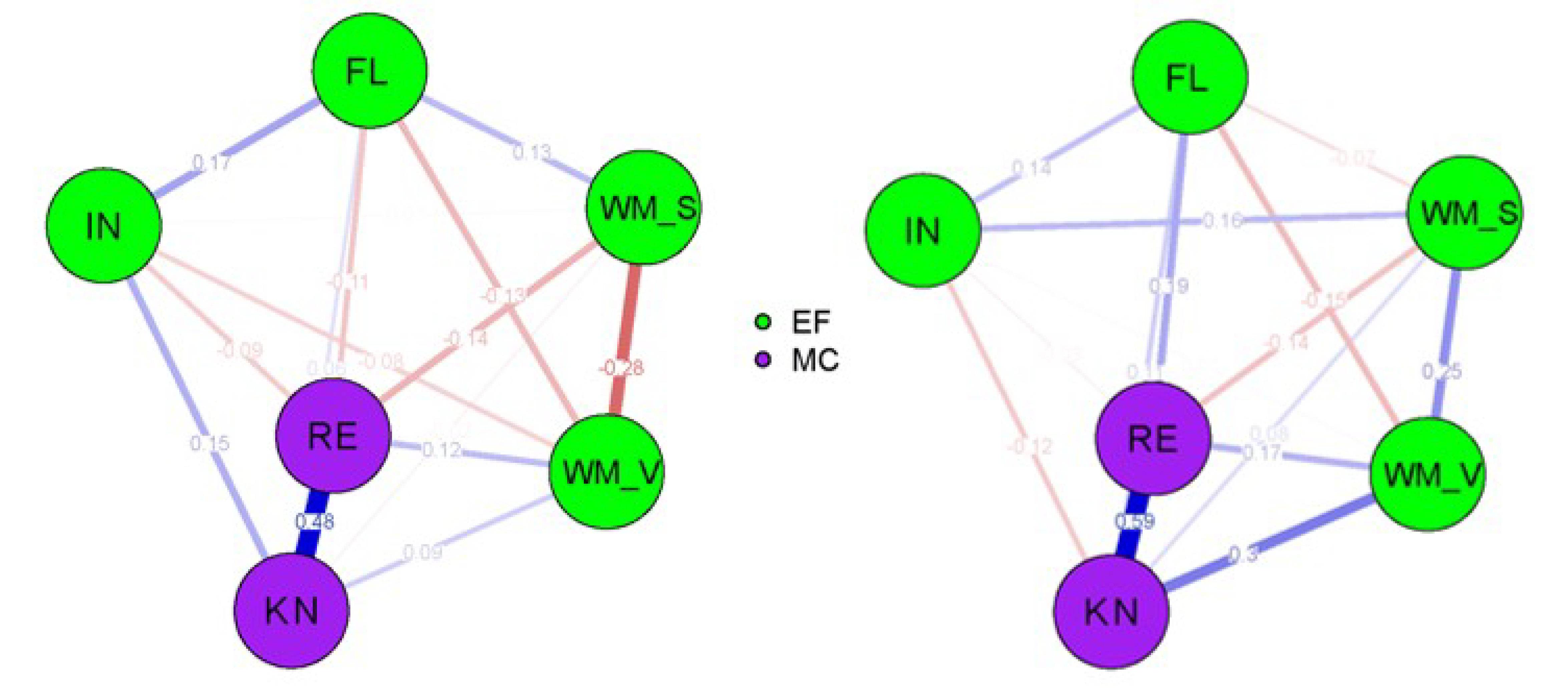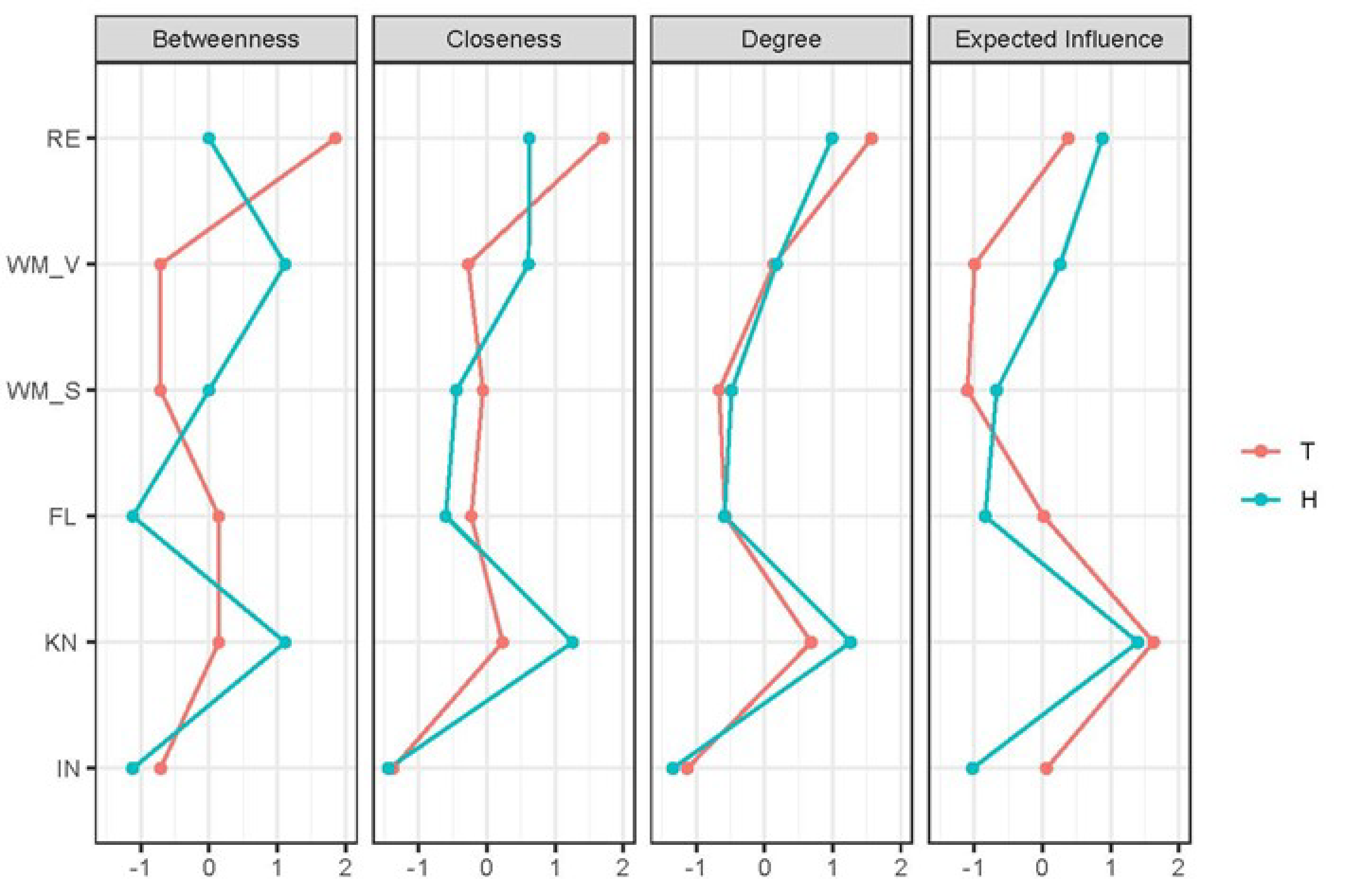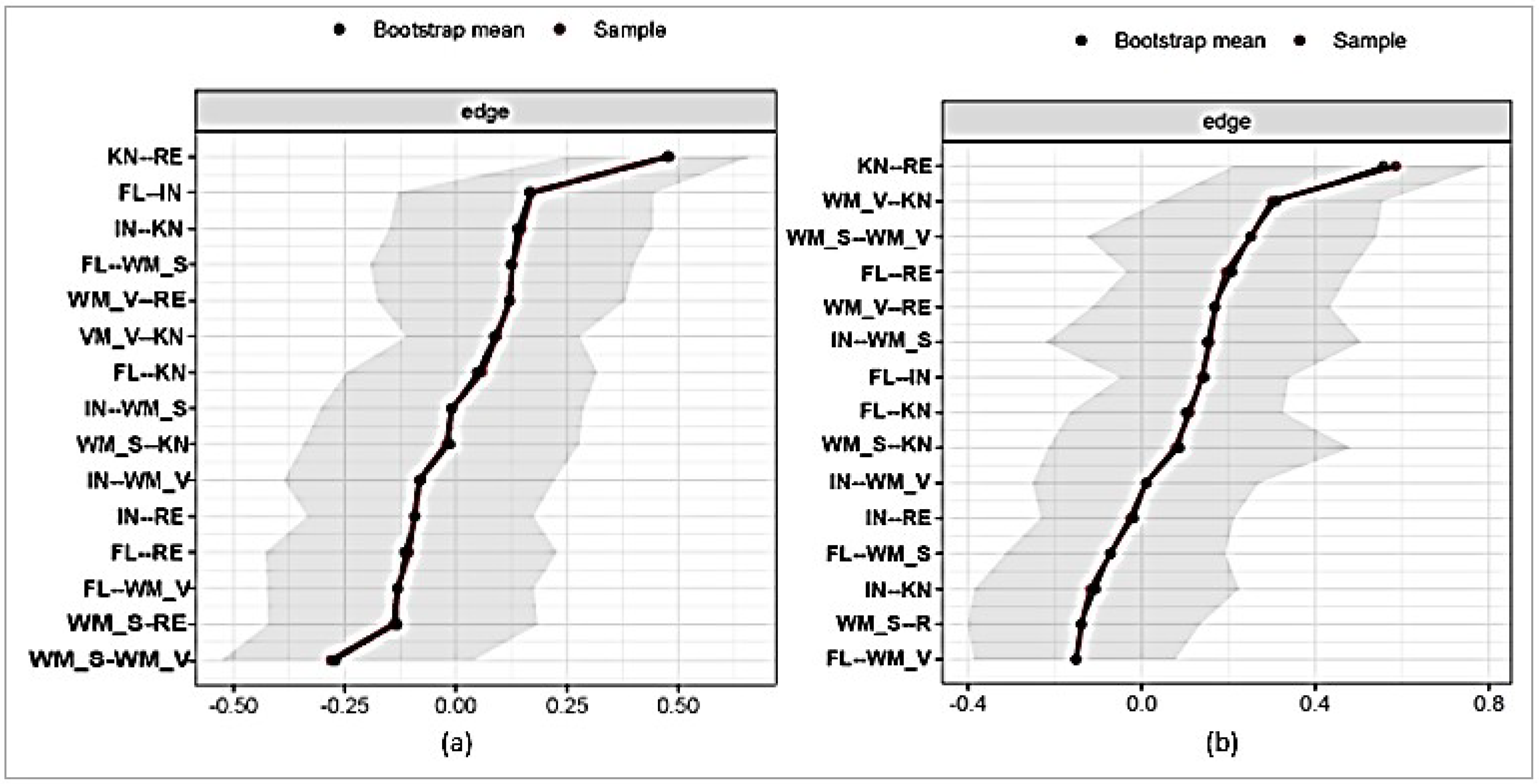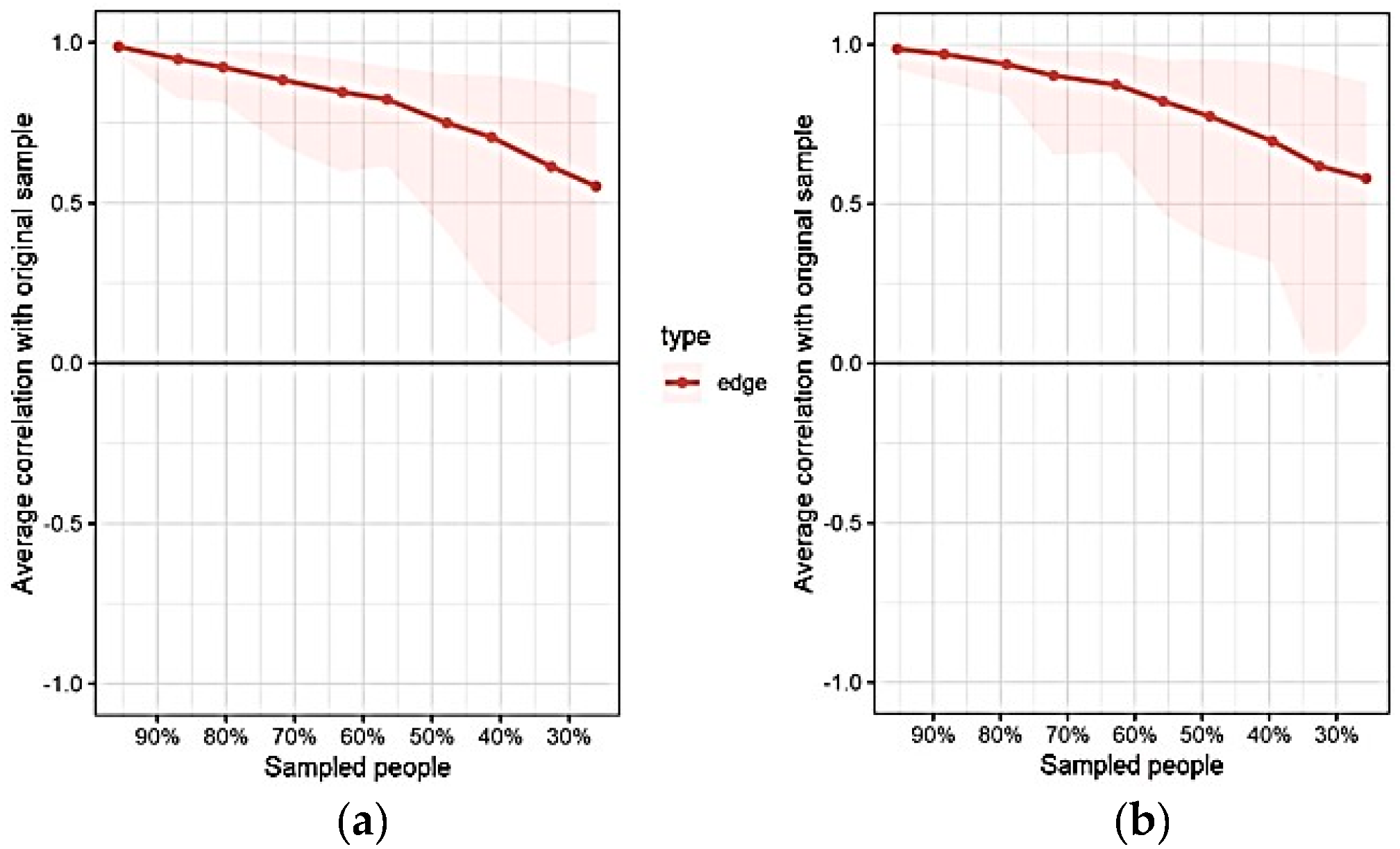Executive Function and Metacognition: Relations and Measure on High Intellectual Ability and Typical Schoolchildren
Abstract
:1. Introduction
2. Materials and Methods
2.1. Sample
2.2. Instruments
- Executive functions. To capture the core-components of inhibition, flexibility, and working memory (visuospatial and verbal), we administered (a) using the free version of the Psychology Experiment Building Language (PEBL) software (version 0.14) [38]: the (1) Berg Task Card Sorting Test (BCST) [39] as a measure of learning and strategy changes or cognitive flexibility; (2) the Go/NoGo task [40] related to the measure of inhibition; and (3) the Corsi Block Task [41] standardised by Kessels et al. [42] to assess visuospatial working memory; and (b) through the Wechsler Intelligence Scale for children (WISC-V) [43], Digits subtest to evaluate verbal working memory.
2.3. Procedure
- Executive functioning tasks: the BCST (10 min), Go/NoGo task (15 min), and Corsi Block Task (10 min), which together lasted about 50 min including instructions before each task.
- The adapted MAI questionnaire, which lasted about 10 min, including instructions.
- Subsequently, the Digits subtest of the WISC-V (2015) was individually administered, which took an average of 10 min, including instructions.
2.4. Data Analysis
- Calculation of the mean, standard deviation (SD), and deviation of the standard error (SE) descriptive statistics.
- Network analysis using the Fruchterman–Reingold algorithm [46] by employing Haslbeck’s Mixed Graphical Model (MGM) [47] such that if two nodes were connected in the resulting figure, they were considered statistically related after controlling for the effect of all the other variables in the network. To make inferences from the network, we calculated three centrality indices for the nodes: (a) degree-strength, (b) betweenness, (c) closeness, and (d) the expected influence.
3. Results
4. Discussion
5. Conclusions
Author Contributions
Funding
Institutional Review Board Statement
Informed Consent Statement
Data Availability Statement
Conflicts of Interest
References
- Sastre-Riba, S. Moduladores de la expresión de la alta capacidad intlelectual. Medicina 2020, 80, 53–57. [Google Scholar] [PubMed]
- Thomas, M.S.C. A neurocomputational model of developmental trajectories of gifted children under a polygenic model: When are gifted children held back by poor environments? Intelligence 2018, 69, 200–212. [Google Scholar] [CrossRef]
- Chan, R.; Shum, D.; Toulopoulou, T.; Chen, E. Assessment of executive functions: Review of instruments and identification of critical issues. Arch. Clin. Neuropsychol. 2008, 23, 201–216. [Google Scholar] [CrossRef] [PubMed] [Green Version]
- Diamond, A.; Ling, D.S. Conclusions about interventions, programs, and approaches for improving executive functions that appear justified and those that, despite much hype, do not. Dev. Cogn. Neurosci. 2016, 18, 34–48. [Google Scholar] [CrossRef] [PubMed] [Green Version]
- Friedman, N.P.; Miyake, A. Unity and diversity of executive functions: Individual differences as a window on cognitive structure. Cortex 2017, 86, 186–204. [Google Scholar] [CrossRef] [Green Version]
- Perone, S.; Almy, B.; Zelazo, P.D. Toward an understanding of the neural basis of executive function development. In The Neurobiology of Brain and Behavioral Development, 2nd ed.; Gibb, R.L., Kolb, B., Eds.; Elsevier: Asterdam, The Netherlands, 2018; pp. 291–314. [Google Scholar]
- Diamond, D.; Ling, D.S. Review of the evidence on, and fundamental questions about, efforts to improve executive functions, including working memory. In Cognitive and Working Memory Training: Perspectives from Psychology, Neuroscience, and Human Development; Novick, J.M., Bunting, M.F., Dougherty, M.R., Engle, R.W., Eds.; Oxford Scholarship Online: Oxford, UK, 2020; pp. 145–389. [Google Scholar]
- Miyake, A.; Friedman, N.P.; Emerson, M.J.; Witzki, A.H.; Howerter, A. The Unity and Diversity of Executive Functions and Their Contributions to Complex “Frontal Lobe” Tasks: A Latent Variable Analysis. Cogn. Psychol. 2000, 41, 49–100. [Google Scholar] [CrossRef] [Green Version]
- Moffitt, T.E.; Arseneault, L.; Belsky, D.; Dickson, N.; Hancox, R.J.; Harrington, H.; Houts, R.; Poulton, R.; Roberts, B.W.; Ross, S.; et al. A gradient of childhood self-control predicts health, wealth, and public safety. Proc. Natl. Acad. Sci. USA 2011, 108, 2693–26988. [Google Scholar] [CrossRef] [Green Version]
- Roebers, C.M. Executive function and metacognition: Towards a unifying framework of cognitive self-regulation. Dev. Rev. 2017, 45, 31–51. [Google Scholar] [CrossRef]
- Blair, C.; Razza, R.P. Relating Effortful Control, Executive Function, and False Belief Understanding to Emerging Math and Literacy Ability in Kindergarten. Child Dev. 2007, 2, 647–663. [Google Scholar] [CrossRef]
- Engelhardt, L.E.; Mann, F.D.; Briley, D.A.; Church, J.A.; Harden, K.P.; Tucker-Drob, E.M. Strong genetic overlap between executive functions and intelligence. J. Exp. Psychol. Gen. 2016, 145, 1141–1159. [Google Scholar] [CrossRef]
- He, L.; Liu, W.; Zhuang, K.; Meng, J.; Qiu, J. Executive function-related functional connectomes predict intellectual abilities. Intelligence 2021, 85, 101527. [Google Scholar] [CrossRef]
- Viana-Sáenz, L.; Sastre-Riba, S.; Urraca-Martínez, M.L.; Botella, J. Measurement of Executive Functioning and High Intellectual Ability in Childhood: A Comparative Meta-Analysis. Sustainability 2020, 12, 4796. [Google Scholar] [CrossRef]
- Schneider, W. Memory. Encycl. Adolesc. 2011, 1, 213–222. [Google Scholar] [CrossRef]
- Organización para la Cooperación del Desarrollo Económicos (OCDE). Informe PISA. Available online: https://www.oecd.org/pisa/publications/ (accessed on 15 September 2021).
- Schneider, W.; Schlagmüller, M.; Visé, M. The impact of metamemory and domain-specific knowledge on memory performance. Eur. J. Psychol. Educ. 1998, 13, 91–103. [Google Scholar] [CrossRef]
- Roebers, C.M.; Schmid, C.; Roderer, T. Metacognitive monitoring and control processes involved in primary school children’s test performance. Br. J. Educ. Psychol. 2009, 79, 749–767. [Google Scholar] [CrossRef] [PubMed]
- Schneider, W. Metacognition and memory development in childhood and adolescence. In Metacognition, Strategy Use, and Instruction; Walter, H.S., Schneider, W., Eds.; Guildford Press: New York, NY, USA, 2010; pp. 54–81. [Google Scholar]
- Efklides, A. Interactions of metacognition with motivation and affect in self-regulated learning: The MASRL model. Educ. Psychol. 2011, 46, 6–25. [Google Scholar] [CrossRef]
- Winne, P.H.; Hadwin, A.F. The weave of motivation and self-regulated learning. In Motivation and Self-Regulated Learning: Theory, Research, and Application; Schunk, D., Zimmerman, B.J., Eds.; Erlbaum: Mahwah, NJ, USA, 2008; pp. 297–314. [Google Scholar]
- Renzulli, J. The Catch-A-Wave Theory of Adaptability: Core Competencies for Developing Gifted Behaviors in the Second Machine Age of Technology. Int. J. Talent Dev. Creat. 2020, 8, 79–95. [Google Scholar]
- Thomas, M.S.C. Response to Dougherty and Robey (2018) on Neuroscience and Education: Enough Bridge Metaphors—Interdisciplinary Research Offers the Best Hope for Progress. Curr. Dir. Psychol. Sci. 2019, 28, 337–340. [Google Scholar] [CrossRef]
- Greene, J.A.; Azevedo, R.A. Theoretical Review of Winne and Hadwin’s Model of Self-Regulated Learning: New Perspectives and Directions. Rev. Educ. Res. 2007, 77, 334–372. [Google Scholar] [CrossRef] [Green Version]
- Rinne, L.; Mazzocco, M. Knowing Right from Wrong in Mental Arithmetic Judgments: Calibration of Confidence Predicts the Development of Accuracy. PLoS ONE 2014, 9, e98663. [Google Scholar] [CrossRef]
- Haberkorn, K.; Lockl, K.; Pohl, S.; Ebert, S.; Weinert, S. Metacognitive knowledge in children at early elementary school. Metacogn. Learn. 2014, 9, 239–263. [Google Scholar] [CrossRef]
- Schraw, G.; Dennison, R.S. Assessing Metacognitive Awareness. Contemp. Educ. Psychol. 1994, 19, 460–475. [Google Scholar] [CrossRef]
- Bellon, E.; Fias, W.; De Smedt, B. More than number sense: The additional role of executive functions and metacognition in arithmetic. J. Exp. Child Psychol. 2019, 182, 38–60. [Google Scholar] [CrossRef]
- Lyons, K.E.; Zelazo, P.D. Monitoring, metacognition, and executive function: Elucidating the role of self-reflection in the development of self-regulation. Adv. Child Dev. Behav. 2011, 40, 379–412. [Google Scholar] [CrossRef]
- Morrison, F.J.; Grammer, J.K. Conceptual clutter and measurement mayhem: Proposals for cross-disciplinary integration in conceptualizing and measuring executive function. In Executive Function in Preschool-Age Children: Integrating Measurement, Neurodevelopment, and Translational Research; Griffin, J.A., McCardle, P.P., Freund, L.S., Eds.; American Psychological Association: Washington, DC, USA, 2016; pp. 327–348. [Google Scholar] [CrossRef]
- Roebers, C.M.; Mayer, B.; Steiner, M.; Bayard, N.S.; van Loon, M.H. The role of children’s metacognitive experiences for cue utilization and monitoring accuracy: A longitudinal study. Dev. Psychol. 2019, 55, 2077–2089. [Google Scholar] [CrossRef] [PubMed]
- Chevalier, N.; Martis, S.B.; Curran, T.; Munakata, Y. Metacognitive Processes in Executive Control Development: The Case of Reactive and Proactive Control. J. Cogn. Neurosci. 2015, 27, 1125–1136. [Google Scholar] [CrossRef] [PubMed] [Green Version]
- Roebers, C.M.; Feurer, E. Linking Executive Functions and Procedural Metacognition. Child Dev. Perspect. 2016, 10, 39–44. [Google Scholar] [CrossRef]
- Oppong, E.; Shore, B.M.; Muis, K.R. Clarifying the Connections Among Giftedness, Metacognition, Self-Regulation, and Self-Regulated Learning: Implications for Theory and Practice. Gift. Child Q. 2019, 63, 102–109. [Google Scholar] [CrossRef]
- Miyake, A.; Friedman, N.P. The Nature and Organization of Individual Differences in Executive Functions. Curr. Dir. Psychol. Sci. 2012, 21, 8–14. [Google Scholar] [CrossRef]
- Van Der Maas, H.; Kan, K.-J.; Marsman, M.; Stevenson, C.E. Network Models for Cognitive Development and Intelligence. J. Intell. 2017, 5, 16. [Google Scholar] [CrossRef] [Green Version]
- Castelló, A. Fundamentos intelectuales de la excepcionalidad: Un esquema de integración. Rev. Española Pedagog. 2008, 66, 203–220. [Google Scholar]
- Mueller, S.T.; Piper, B.J. The Psychology Experiment Building Language (PEBL) and PEBL Test Battery. J. Neurosci. Methods 2014, 222, 250–259. [Google Scholar] [CrossRef] [Green Version]
- Berg, E.A. A simple objective technique for measuring flexibility in thinking. J. Gen. Psychol. 1948, 39, 15–22. [Google Scholar] [CrossRef]
- Bezdjian, S.; Baker, L.A.; Lozano, D.I.; Raine, A. Assessing inattention and impulsivity in children during the Go/NoGo task. Br. J. Dev. Psychol. 2009, 27, 365–383. [Google Scholar] [CrossRef] [PubMed] [Green Version]
- Corsi, P.M. Human Memory and the Medial Temporal Region of the Brain. Ph.D. Thesis, McGill University, Montreal, QC, Canada, 1972. [Google Scholar]
- Kessels, R.P.C.; van Zandvoort, M.J.E.; Postma, A.; Kappelle, L.J.; de Haan, E.H.F. The Corsi Block-Tapping Task: Standardization and Normative Data. Appl. Neuropsychol. 2000, 7, 252–258. [Google Scholar] [CrossRef] [PubMed]
- Wechsler, D. WISC-V. Escala de Inteligencia de Wechsler Para Niños-V; Pearson: Madrid, Spain, 2015. [Google Scholar]
- Domenech-Aunqué, M. El Papel de la Inteligencia y de la Metacognición en la Resolución de Problemas. Ph.D. Thesis, Universitat Rovira i Virgili, Tarragona, Spain, 2004. [Google Scholar]
- Sperling, R.A.; Howard, B.C.; Miller, L.A.; Murphy, C. Measures of Children’s Knowledge and Regulation of Cognition. Contemp. Educ. Psychol. 2002, 27, 51–79. [Google Scholar] [CrossRef] [Green Version]
- Fruchterman, T.M.J.; Reingold, E.M. Graph drawing by force-directed placement. Softw. Pract. Exp. 1991, 21, 1129–1164. [Google Scholar] [CrossRef]
- Haslbeck, J. Mgm: Estimating Time-Varying k-Order Mixed Graphical Models. Available online: https://cran.r-project.org/web/Packages/Mgm/Mgm.Pdf (accessed on 15 September 2021).
- Epskamp, S.; Borsboom, D.; Fried, E.I. Estimating psychological networks and their accuracy: A tutorial paper. Behav. Res. 2018, 50, 195–212. [Google Scholar] [CrossRef] [PubMed] [Green Version]
- IBM Corp. Released. IBM SPSS Statistics for Windows, Versión 24.0; IBM Corp: Armonk, NY, USA, 2016. [Google Scholar]
- R Development Core Team. R: A Language and Environment for Statistical Computing; R Foundation for Statistical Computing: Vienna, Austria, 2013. [Google Scholar]
- Epskamp, S.; Cramer, A.O.J.; Waldorp, L.J.; Schmittman, V.D.; Borsboom, D. qgraph: Network Visualizations of Relationships in Psychometric Data. J. Softw. Stat. 2012, 48, 11–18. [Google Scholar] [CrossRef] [Green Version]
- Subotnik, R.F.; Olszewski-Kubilius, P.; Worrell, F.C. Talent development as the most promising focus of giftedness and gifted education. In APA Handbook of Giftedness and Talent; Pfeiffer, S.I., Shaunessy-Dedrick, E., Foley-Nicpon, M., Eds.; American Psychological Association (APA): Washington, DC, USA, 2018; pp. 21–245. [Google Scholar] [CrossRef]
- Bryce, D.; Whitebread, D.; Szűcs, D. The relationships among executive functions, metacognitive skills and educational achievement in 5 and 7 year-old children. Metacogn. Learn. 2015, 10, 181–198. [Google Scholar] [CrossRef]




| M | SD | SE | |||||
|---|---|---|---|---|---|---|---|
| HIA | Typical | HIA | Typical | HIA | Typical | ||
| BCST | Categories completed | 5.209 | 5.021 | 1.946 | 3.044 | 0.296 | 0.448 |
| Perseverative errors | 14.361 | 29.748 | 5.015 | 17.075 | 0.764 | 2.517 | |
| Set maintenance errors | 2.627 | 1.804 | 1.234 | 1.485 | 0.188 | 0.218 | |
| GO/NO-GO | Total correct | 276.767 | 282.782 | 27.054 | 23.438 | 4.125 | 3.455 |
| Total errors | 43.255 | 37.217 | 26.952 | 23.438 | 4.110 | 3.455 | |
| CORSI BLOCK | Block span | 5.000 | 4.902 | 0.872 | 0.916 | 0.133 | 0.135 |
| DIGIT | Direct digits | 9.090 | 7.410 | 1.477 | 2.671 | 0.225 | 0.394 |
| Reverse digits | 8.140 | 6.760 | 1.754 | 1.876 | 0.267 | 0.277 | |
| Total digits | 17.210 | 14.170 | 2.596 | 3.302 | 0.396 | 0.487 | |
| MAI | Consciousness | 4.08206 | 4.03206 | 0.553 | 0.428 | 0.084 | 0.0632 |
| Regulation | 3.259 | 3.442 | 0.732 | 0.571 | 0.111 | 0.084 | |
Publisher’s Note: MDPI stays neutral with regard to jurisdictional claims in published maps and institutional affiliations. |
© 2021 by the authors. Licensee MDPI, Basel, Switzerland. This article is an open access article distributed under the terms and conditions of the Creative Commons Attribution (CC BY) license (https://creativecommons.org/licenses/by/4.0/).
Share and Cite
Viana-Sáenz, L.; Sastre-Riba, S.; Urraca-Martínez, M.L. Executive Function and Metacognition: Relations and Measure on High Intellectual Ability and Typical Schoolchildren. Sustainability 2021, 13, 13083. https://doi.org/10.3390/su132313083
Viana-Sáenz L, Sastre-Riba S, Urraca-Martínez ML. Executive Function and Metacognition: Relations and Measure on High Intellectual Ability and Typical Schoolchildren. Sustainability. 2021; 13(23):13083. https://doi.org/10.3390/su132313083
Chicago/Turabian StyleViana-Sáenz, Lourdes, Sylvia Sastre-Riba, and Mª Luz Urraca-Martínez. 2021. "Executive Function and Metacognition: Relations and Measure on High Intellectual Ability and Typical Schoolchildren" Sustainability 13, no. 23: 13083. https://doi.org/10.3390/su132313083
APA StyleViana-Sáenz, L., Sastre-Riba, S., & Urraca-Martínez, M. L. (2021). Executive Function and Metacognition: Relations and Measure on High Intellectual Ability and Typical Schoolchildren. Sustainability, 13(23), 13083. https://doi.org/10.3390/su132313083






